23rd
May - 8nd June 2012
As it turns out,
sitting around drinking beer and eating pizza is not a good way to
get fit for cycling, and unsurprisingly we flaked out after only 70km
to collapse into a motel in a little town off the highway. Our
strength gradually returned though, and after another abrupt 70km day
that got us into Surat Thani we started punching over the 100km a day
mark once again.
At this point,
heading north from Surat Thani, Thailand finds herself getting
squeezed up against Burma for 500km along a long, narrow neck of land
between the Gulf of Thailand and the Andaman Sea. This lanky corridor
has a superb title: “The Isthmus of Kra”. To my mind this sounds
exactly like the kind of place to set an 80's synth soundtracked
fantasy movie, and though we did not see any unicorn riding maidens,
or any oiled up, sword wielding men, (although I did listen to a spot
of Foreigner during the ride), we were daily beset by the
baddies that prowl the Isthmus, those fanged beasts, anathema to
cyclists, postmen, and unicorn riding maidens alike; lairy, hairy,
and sometimes a little bit scary, the four legged orcs of Thailand –
dogs.
Bloody dogs. Daily
- pretty much hourly actually - our pedalling was interrupted as one,
two, three dogs caught wind of the newcomers in their territory and
came hurtling down the road after us. They snapped and barked around us,
but most of the time our trick of just stopping and walking with the
bikes calmed them down. In fact, quite often when we slam the brakes
on and turn to face the incoming animal it screeches to a halt and
bolts back off where it came from while we wave our fists at it. It
gets tiring though, especially when an assault comes every fifteen
minutes or so. Makes it slow going. And after the seventieth dog has
barked at you in dog to piss off, it starts to wear you down.
“Frog.” I
said, pointing at the frog on the floor.
On the fifth day
since our days off eating frogs we reached the top of the Isthmus.
Thailand swells out now, with Bangkok over to the east, Kanchanaburi
to the west, and Thailand's inland plains and hills to the north. We
decided to bank west, towards Kanchanaburi, the site of the infamous
death railway during the second world war. To get there the choice of
some fairly straight forward back country roads or the dreary highway
was really no choice at all. So we made our way some 130km along
almost deserted roads that lead through some lovely open plains
vibrant with the greens of maize and rice. After so long on the
highway, and despite getting a little bit lost here and there, it was
a dream to get away from the noise and pollution and get down to some
sterling cycling again.
We arrived in
Kanchanaburi quite late, owing to a few misjudged turnings and a
timely puncture, and were welcomed to the city by a large pack of
overly keen dogs that had to be chased away with rocks. We weren't
sure of the layout of the city at all when we arrived, but we managed
to stumble into a really nice little guesthouse, which actually just
so happened to be on the outskirts of the main tourist drag – a
tourist drag that we had no inkling even existed here.
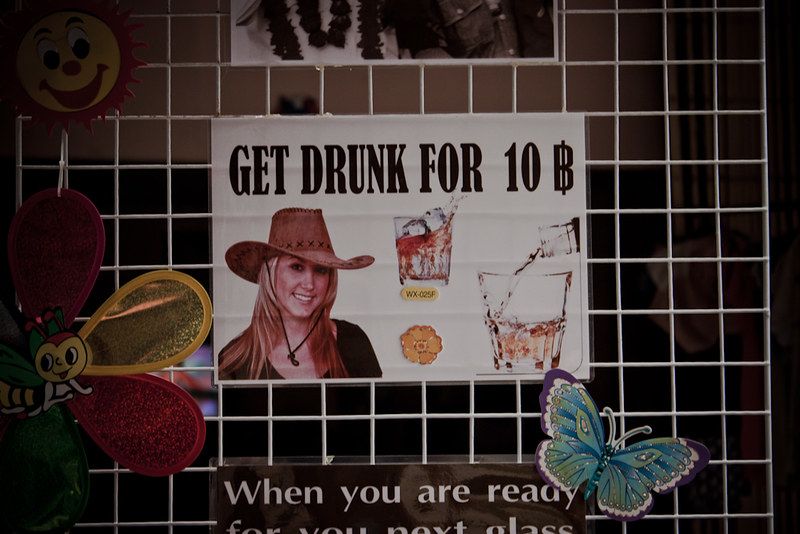 Interesting place,
Kanchanaburi. Much of it's popularity with backpackers stems from its
location beside the Bridge over the River Kwai – the busy tourist
street actually leads right up to it – but owing to its popularity
with the gap year backpacker crowd the street is jam packed with bars
offering cheap alcohol and a good time. The site of a war crime
turning into a place to go and get sloshed doesn't exactly sit very
well with me, it's a bit off, but thankfully Kanchanaburi is also
quite capable of dealing with its history in a very sobering and
informative way, you just have to traipse to the other end of the
tourist strip where the war cemetery and museum lie.
Interesting place,
Kanchanaburi. Much of it's popularity with backpackers stems from its
location beside the Bridge over the River Kwai – the busy tourist
street actually leads right up to it – but owing to its popularity
with the gap year backpacker crowd the street is jam packed with bars
offering cheap alcohol and a good time. The site of a war crime
turning into a place to go and get sloshed doesn't exactly sit very
well with me, it's a bit off, but thankfully Kanchanaburi is also
quite capable of dealing with its history in a very sobering and
informative way, you just have to traipse to the other end of the
tourist strip where the war cemetery and museum lie.
In the early
stages of the second world war though, after Singapore fell, the
Japanese had a very large work force at their disposal, and a desire
to link the two countries to support their efforts against the Allied
forces in Burma. Thousands of POWs were sent there, and work began to
clear the land, lay the tracks, and bridge the rivers.
It was Queeny's
jubilee weekend so all the British Embassies were closed, preventing
us from speaking to anyone about it. Trying to figure out the process
of sending off for a new passport from the information available
online was a nightmare. How, precisely, was Liv supposed to get a
signature from a professional who has known her for more than 3 years
when she's out here in Thailand?
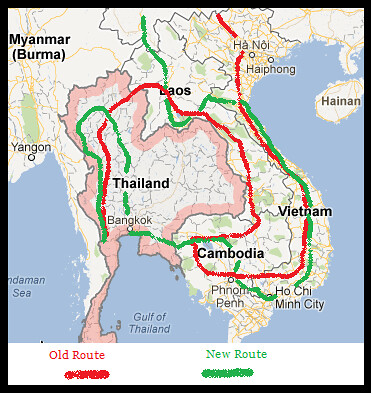 We spent several
hours sizing up our options, and did a bit of rejigging to our
proposed overall route. We decided to shave off some of the longer
stretches in Laos and Vietnam in order to make up for time lost in
Thailand, so we could get to the high mountain passes of southern
China before the winter set in there. The plan now then: Wait for the
passport in Thailand, then head into Cambodia, across to Vietnam,
partway up Vietnam then east into Laos, then north towards Yunnan –
into China, and across to Beijing.
We spent several
hours sizing up our options, and did a bit of rejigging to our
proposed overall route. We decided to shave off some of the longer
stretches in Laos and Vietnam in order to make up for time lost in
Thailand, so we could get to the high mountain passes of southern
China before the winter set in there. The plan now then: Wait for the
passport in Thailand, then head into Cambodia, across to Vietnam,
partway up Vietnam then east into Laos, then north towards Yunnan –
into China, and across to Beijing.
4676 – 5597km
Nakhon Si
Thammarat – Surat Thani - Bang Saphan Noi – Prachuap Kiri Khan – Hua Hin - Pak Tho – Kanchanaburi
Hounded up
the Isthmus
We were somewhat
naive the day we left Martyn's house, setting ourselves the goal of
reaching Surat Thani by the first evening, despite the fact it lay
some 140km away. By our reckoning all those days we'd had
lately relaxing and unwinding, scoffing food and watching TV, would
mean we'd be well rested and capable of tackling a monster day in the saddle. We were
wrong.
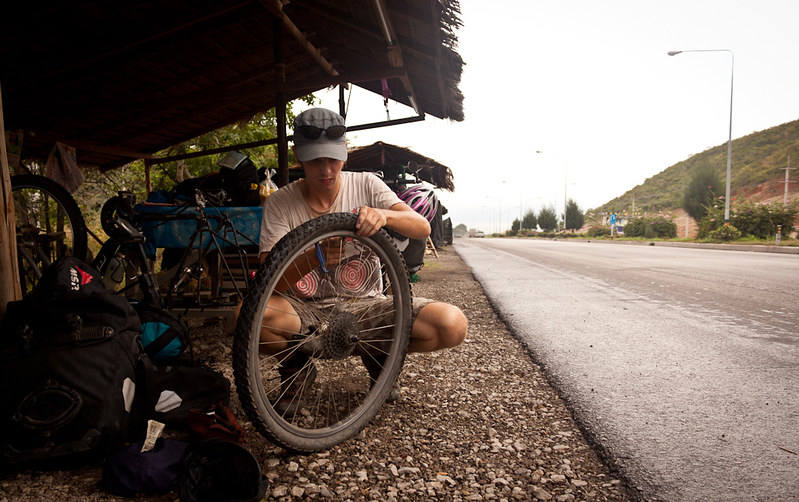 |
| Our fattened bellies weren't the only thing that held us up though.... |
 |
| In Thailand there are people driving up and down the roads selling everything from pancakes to pineapples. Here's Robin buying delicious mangos. |
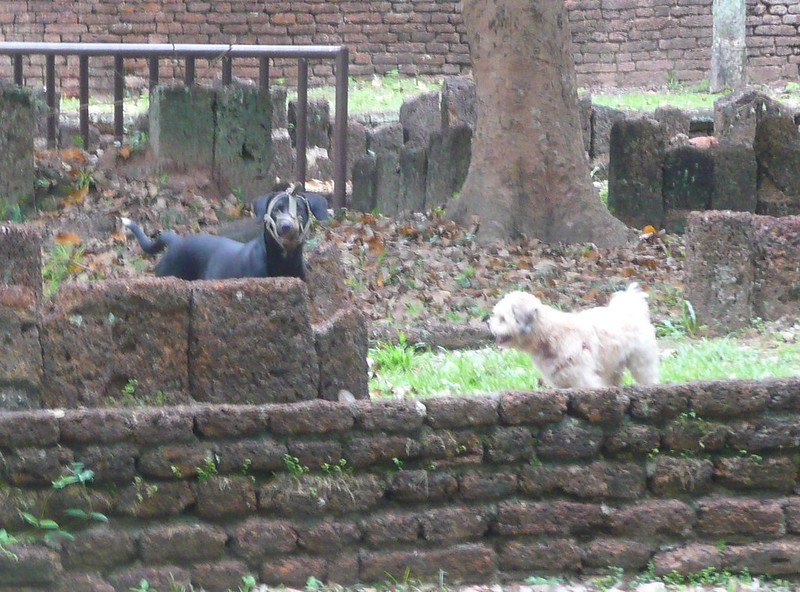 |
| An evil looking dog in a muzzle, and it's trusty sidekick Patsy. |
Occasionally we
came across a particularly boisterous bunch who kept on at us after
we'd got off the bikes and sworn at them. Thankfully we have a Plan
B, which involves throwing stones – or rather, acting as if we're
about to, and so far this has deterred even the bravest of street
dogs.
The real danger
comes when you don't see the bastards coming, and since they come so
frequently, and from just about every angle, the odds are that this
will happen from time to time.
Case in point: one
lovely morning we were riding along an empty stretch of road,
tootling along at somewhere between 15 and 20km an hour. Liv was in
front of me, and we were cruising along enjoying the breeze. A few
grey clouds about, it was still an hour or two off midday so the
temperature was amiable, and the sky was shot with the golden light
of a glorious day. Mmm, isn't life wonderful. Fa la la la la.
Just then, I heard
a quick skittering of paws on the tarmac beside me, and as I turned
to look I was rather surprised to see a large brown dog in mid-air
about to collide with my bicycle. The hound's bold leap terminated
with a thwack on the back of my bike, his front paws found purchase
on my rear panniers, and although his hind legs could only scrabble
at the sides it did manage to hang on long enough to get a free ride
a few metres down the road. I think the dog was more surprised than
me at the situation though, because after having a
distracted snap at me, it came cartwheeling off and bolted back
across the road in alarm at the quick, bizarre events that had taken
place. Ran away, that is, until its instincts twanged back into
action and forced it to dash back after the intruding cyclist, but by
now I was too far away and going too fast for a rerun.
They liven things
up, I suppose, but it does get very annoying; stopping every few
minutes to shout at a band of barking animals dancing around us. But
despite the regular interruptions, and our depleted fitness, we
started making good progress, and gradually wound our way up north.
Hippy-hoppy-happy
After five days'
riding we came to a small coastal township called Bang Saphan Noi.
The sun was going down, and we'd clocked well over a hundred kay that
day, but our luck finding accommodation seemed to be thin on the
ground. We were knackered and were willing to take anywhere within
our price range, but after rolling through the town's few streets and
empty market square we discovered there was actually nowhere to stay
in town at all.
We rode towards
the coast, hoping that there might be a few places along there. There
were. One weird collection of very expensive rooms by a dirty estuary
and small rural village, totally out of place, and charging somewhere
in the region of $100 a night. No thanks.
The other was
advertised as being some 20km down the road, but that was 20km back
the way we had come from. We decided against backtracking in favour
of pushing on up the road with our fingers crossed that something
showed up.
Our gamble paid
off nicely. After just a kilometre or two we saw a sign for a resort
tucked away off the road. We rode down the lane just as the sun
disappeared below the horizon, and came across a lovely collection of
rooms decorated with seashells and blue paint, surrounding a wooden
dining area adorned with paintings and maritime bits and bobs. The
price was steep though, pretty much our entire daily budget, but when
we explained our situation, and said we would spend three nights
there, they knocked two hundred baht off the price - nearly 50% - so
we snapped it up.
We had two very
lazy, but very luxurious days in that place. The woman who had
translated for us and helped us nail the bargain price turned out to
be an English teacher called Arom, down from Bangkok for the weekend.
We enjoyed dinner with her on our second night, talking about her
job, and our bicycle ride, and this, and that.
The next afternoon
Arom left, making us two the only guests there, but after dinner the
owners and staff invited us to join them for some whiskey and snacks
around the table. It was a brilliant night. Our Thai was nowhere
nearing a conversational standard, and their English was just as bad.
The chef knew only three phrases of English: “Happy”, “No”
and “1, 2, 3.” God bless her, she spent a very long time - and I
mean a very long time – that night, trying to make sentences
out of those. Lot's of hand gestures, waving, and “No. Happy.” a
flurry of hands “One, two. Happy(?)”
Liv and I politely
strained to grasp the meaning, but one of the owners just laughed,
poured out some more whiskey, and turned up the music. Sweet fried
fish was served, along with chilli fried frog. We think it was frog
anyway, it tasted a lot like McDonalds beef burgers in all honesty,
but we were told it was “Froh”, and when we did our frog
impressions they were met with a laugh and a nod. It can't have been
beef at any rate, because it was full of tiny bones that you had to
crunch and grind in your mouth, like some fairy tale giant, before
swallowing it down. Strange, but surprisingly tasty.
As the night wore
on hundreds of flying ants emerged and began swarming around the
lamps. They were everywhere, falling in the food, in our drinks. The
floor was covered in them. And then along came a very fat looking
frog, hopping along the floor and snapping them up one after another.
One frog with about a thousand ants for dinner. Lucky guy. We pointed
at the dish on the table, then pointed at the frog to confirm
matters, and everybody nodded.
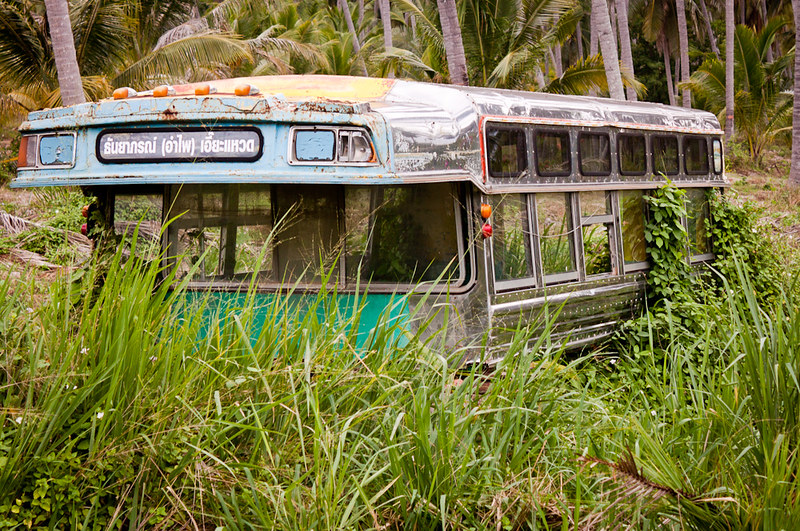 |
| We see a lot of things covered in grass and vines. |
The owner pointed
at him too, to correct me, “Happy!” he said, and we all laughed.
We went to bed
happy that night too, although we woke up feeling a wee bit groggy.
We saddled up the bikes and crunched across the gravel drive in the
cooler air of morning, some of the staff were sat by the gate and
waved us off as we set off up the road. The roads around here were
quiet, especially at this early hour, and our cloudy heads soon
relaxed into a lovely morning of- #WOOF WOOF WOOF! God
dammit...
The Death
Railway
For four days we
rode north, following the highway that snaked up close to the coast.
The ride was quite reasonable, but not exactly enthralling, despite
the regular excitement the dogs kindly brought with them. The highway
was as dull as dishwater – endless kilometres of flat grey road,
lorries rumbling by, cars honking hellos, stopping every couple of
hours for a cold drink or a cornetto or yet another plate of fried
rice. There were a web of country lanes that led off from this main
road, but because they zig-zagged all over the place they invariably
added ten or twenty kilometres to our day whenever we ventured down
them. We tried it a few times, but the increased distance it brought,
along with an increasing number of dogs, kept us on the highway for
the most part.
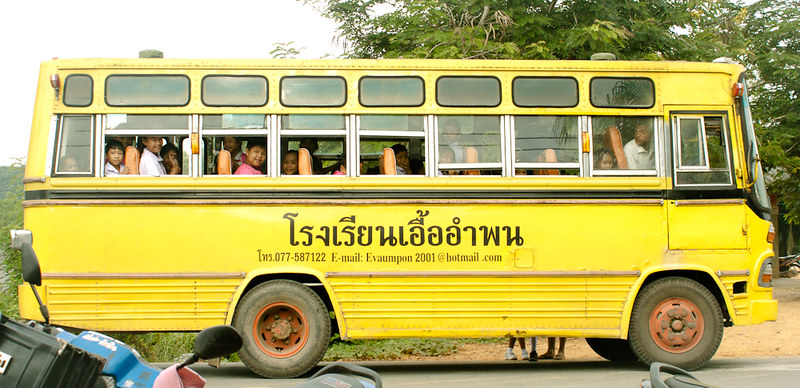 |
| We joined a bunch of kids in a small cafe for breakfast before they went off to school. |
 |
| Off the highways the roads are quiet and beautiful. |
 Interesting place,
Kanchanaburi. Much of it's popularity with backpackers stems from its
location beside the Bridge over the River Kwai – the busy tourist
street actually leads right up to it – but owing to its popularity
with the gap year backpacker crowd the street is jam packed with bars
offering cheap alcohol and a good time. The site of a war crime
turning into a place to go and get sloshed doesn't exactly sit very
well with me, it's a bit off, but thankfully Kanchanaburi is also
quite capable of dealing with its history in a very sobering and
informative way, you just have to traipse to the other end of the
tourist strip where the war cemetery and museum lie.
Interesting place,
Kanchanaburi. Much of it's popularity with backpackers stems from its
location beside the Bridge over the River Kwai – the busy tourist
street actually leads right up to it – but owing to its popularity
with the gap year backpacker crowd the street is jam packed with bars
offering cheap alcohol and a good time. The site of a war crime
turning into a place to go and get sloshed doesn't exactly sit very
well with me, it's a bit off, but thankfully Kanchanaburi is also
quite capable of dealing with its history in a very sobering and
informative way, you just have to traipse to the other end of the
tourist strip where the war cemetery and museum lie.
We did not know a
great deal about the death railway when we arrived here, and were
attracted, let's be quite honest, like the rest of um, by the Bridge
of River Kwai fame. On our second evening in town we watched the
movie, and very good movie it is too, and then we headed to the war
museum to try to get our heads around it all.
Linking Burma and
Thailand by rail had been considered, and dismissed, by the British
before the outbreak of war. Too difficult, too dangerous, was the
consensus. The land between Bangkok and Rangoon was loping hills,
solid rock, and thick with jungle, it would be a nightmare to attempt
anything of the sort.
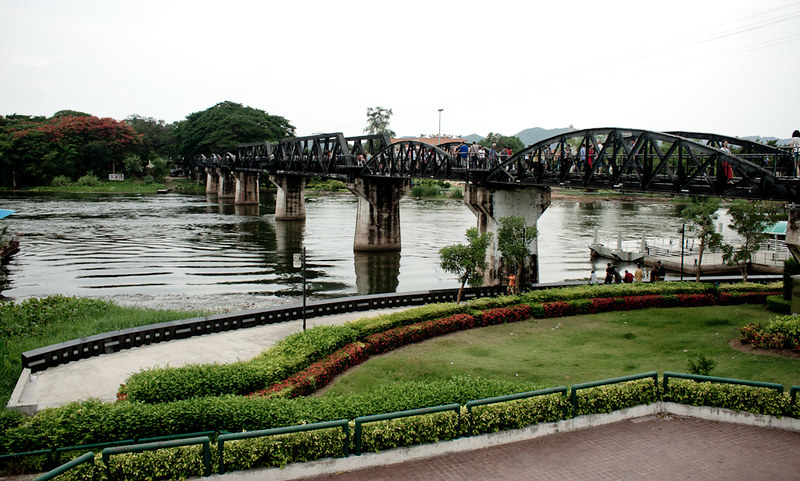 |
| The bridge on the river Kwai, or rather the replacement after the original was blown to smithereens, not by Alec Guinnes but Allied bombers. |
Exhausting labour
for up to 18 hours a day, insufficient food, malaria and cholera
ravaging the camps, and brutal, swift and sudden punishment for
anybody not seen to be working hard enough. It sounded horrendous. Of
the 330'000 people who worked on the Burma Railway, it is estimated
that over 100'000 died.
As the deadline
for completion drew nearer, the guards and engineers demanded more
from their already weakened workers, pushing up the death toll. Then
when the monsoons came the mosquito population soared, spreading more
disease, and whittling them further.
Standing in the
war cemetery you get something of the sense of the numbers, and it's
all the more harrowing knowing that much of it was unnecessary.
Prisoners were dying of exhaustion, starvation, and from the brutal
punishments – these could have been avoided, and the railway still
would have been built. It seems to have been a case of orders from
the top demanding a schedule that could not be met, and a few
malicious people finding themselves in positions of power, using
their status to bully, torture, and kill.
Perhaps the most
unsettling fact for me though is the enormous toll on the local
populations. Burmese were enlisted by the Japanese to work alongside
the Allied POWs, as were Malays, Indians and Thais. Some were tempted
in with the promise of decent employment, but when this failed to
draw in the numbers, teams of Japanese went around kidnapping and
dragging people in to work. 90'000 Asian workers died on the railway,
more than five times the number of Allied POWs, and while the
Japanese saw to it that the Allied dead saw proper burial, the tens
of thousands of Asians who died saw no such treatment. They died, and
were disposed of, their last resting place unknown.
It makes you
think. But while a remembrance of the past is vital, one cannot dwell
on things too long. Maybe it is a good thing that Kanchanaburi is a
place to have fun now, as well as visiting these historic sites and
have a think about things. If you're ever in town the museum is
really excellent. The bars... not so much.
Bad news on the
Death Railway
Fun was not going
to be on the cards for the next few days though, because while we
were flicking through some travel blogs, figuring out where we were
heading next, we realised something; Liv's passport did not have
enough blank pages left to accommodate the number of visas we needed
to get to Beijing.
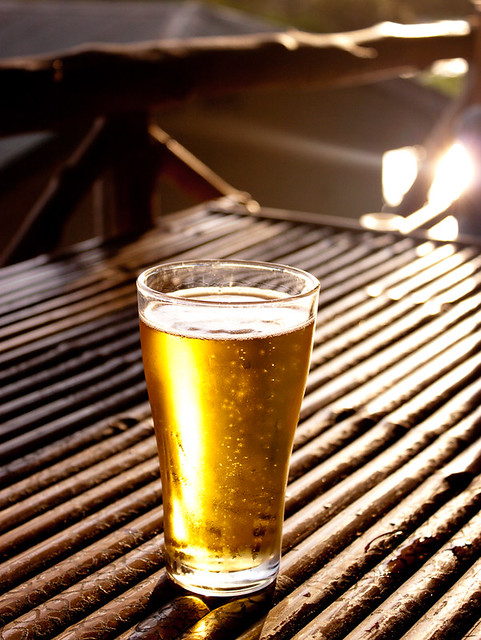 |
| Well, we did have some fun. |
Gradually the
information came in, then changed, then changed again, but after a
couple of days the forms were filled in, photos taken, with no
professional's signature required, as suggested by the
British Embassy in Bangkok, later denied by the passport office in
Beijing before denying their denial and saying it should be fine.
Trouble was though, we were now stuck in Thailand while we waited for
the passport to come back. A whole four weeks, right when we were
getting ready to leave.
 We spent several
hours sizing up our options, and did a bit of rejigging to our
proposed overall route. We decided to shave off some of the longer
stretches in Laos and Vietnam in order to make up for time lost in
Thailand, so we could get to the high mountain passes of southern
China before the winter set in there. The plan now then: Wait for the
passport in Thailand, then head into Cambodia, across to Vietnam,
partway up Vietnam then east into Laos, then north towards Yunnan –
into China, and across to Beijing.
We spent several
hours sizing up our options, and did a bit of rejigging to our
proposed overall route. We decided to shave off some of the longer
stretches in Laos and Vietnam in order to make up for time lost in
Thailand, so we could get to the high mountain passes of southern
China before the winter set in there. The plan now then: Wait for the
passport in Thailand, then head into Cambodia, across to Vietnam,
partway up Vietnam then east into Laos, then north towards Yunnan –
into China, and across to Beijing.
It wasn't the end
of the world, and in many ways adjustments we made were better than
the previous route, which entailed cycling down the length of Laos,
doing a loop of Cambodia then the entire length of Nam. Great to see
so much of all the countries, but we'd be pushing at 2'000km in the
one month the visas allowed us, and it may well have been a case of
seeing less by trying to see more.
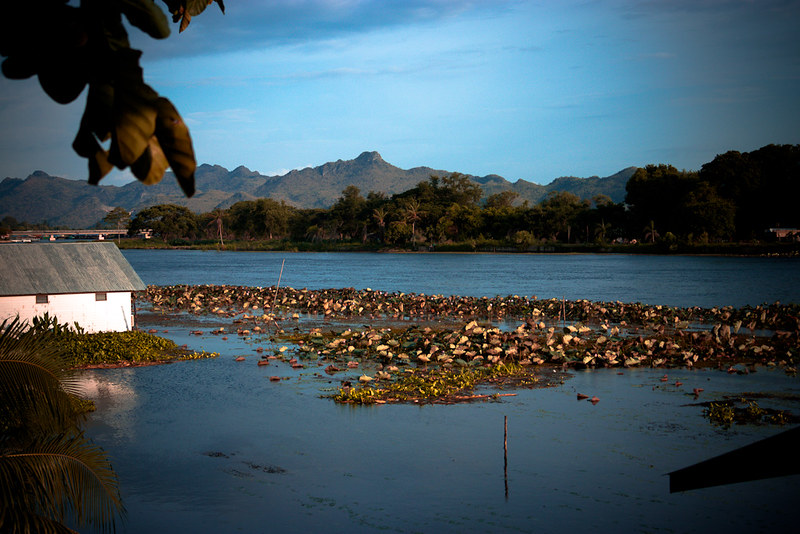 |
| The River Kwai |
We were determined
not to let the whole passport thing get us down, so while Liv was
wrestling with the paradoxes of passport renewal I spent some hours
tracing out an off-piste route through back country roads towards the
north of Thailand, skirting the border of Burma before landing in
Chiang Mai. From there we'd drop back down, via a few ancient Thai
cities and bat caves, to Bangkok in time to grab that pesky passport
before darting into Cambodia..
We had some
interesting riding ahead of us, and to keep us on our toes we both
decided, as we cycled out of Kanchanaburi on the morning of the 8th
June, that we'd try something a little bit different for
accommodation that night. So we pedalled out of town, upbeat, and
excited about the road ahead. We just hope everything goes smoothly
with the passport office...

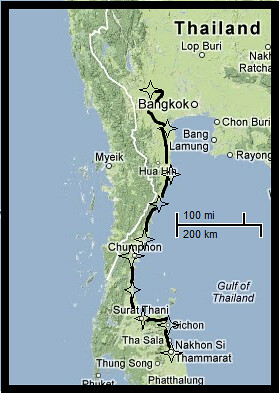

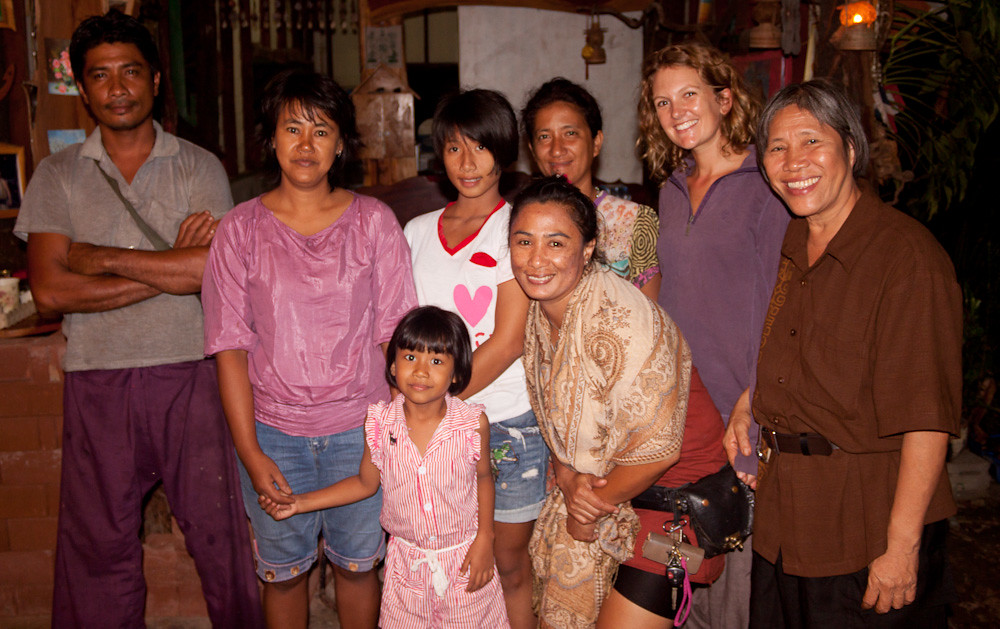

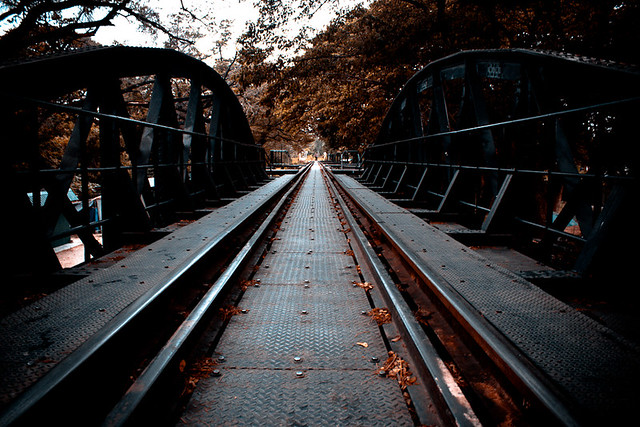

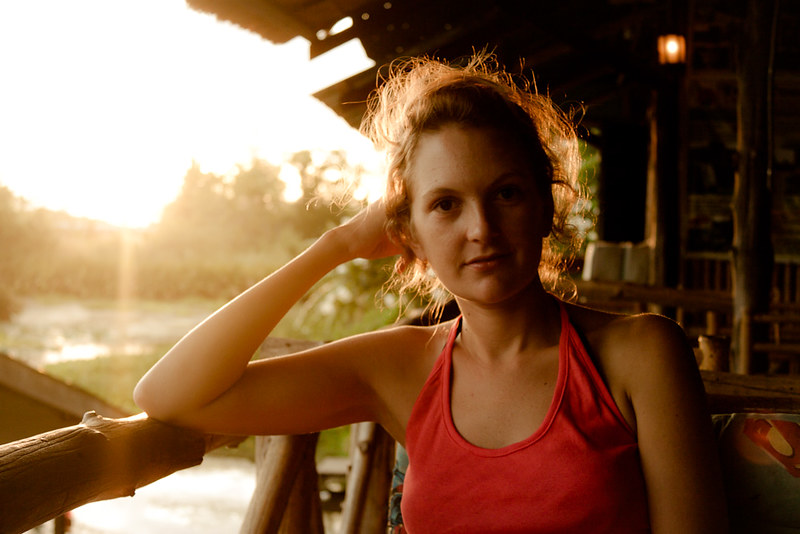
No comments:
Post a Comment